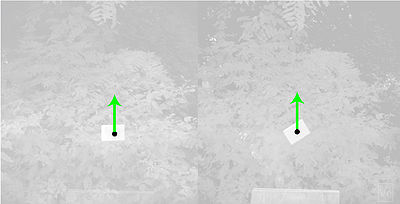Multi-particle Analysis of Momentum
claimed by nacharya7
The Main Idea
The Momentum Principle is a foundation of classical physics that is applicable to almost any system of objects at any scale, micro- or macroscopic. As such it can be used to analyse systems of point particles as well as multi-particle systems; however, there are a few subtleties one needs to take note of when choosing to analyze a multi-particle system that this page will detail.
A Mathematical Model
The Momentum Principle is [math]\displaystyle{ {\frac{d\vec{p}}{dt}}_{system} = \vec{F}_{net} }[/math] where p is the momentum of the system and F is the net force from the surroundings.
The Energy Principle is [math]\displaystyle{ {Δ{E}} = {W} }[/math] where E is the total change of a system's energy ans W is the work done on the system by the surroundings.
You will also need to know how to find the center of mass: [math]\displaystyle{ {cm} = {\frac{\sum{mr}}{{M}_{tot}}} }[/math], where cm is the location of the center of mass relative to an origin, mr is a fractional mass and length product summed up to infinity, and M is the total mass of the system.
Procedure
In order to analyze the motion of a multi-particle system, we need to apply both the energy principle and momentum principle.
Step 0: Identify the system and the surroundings of the system.
Step 1: Compress the system into a point-particle located at the system's center of mass.
[insert image later]
Step 2: Apply all forces acting on the system with their tails connected to the center of mass, retaining direction and magnitude.
[insert image later]
Step 3: Use the energy principle on the point particle.
[math]\displaystyle{ Δ{K} = Δ{W}_{trans} = \vec{F} * Δ{r}_{cm} }[/math]
Step 4: Return to the real-system and visualize the initial and final states of the systems.
[insert images]
Step 5: Calculate the work that each force does
Step 6: Set up the Energy Principle for the problem.
[math]\displaystyle{ Δ{K}_{trans} + Δ{K}_{rot} + Δ{U} = {W}_{surr} + {Q} }[/math]
Examples
Problem Description
Two wooden blocks of mass [math]\displaystyle{ {\vec{m}} }[/math] are shot by a bullet on a vertical apparatus such that the first wooden block along the axis of its center of mass while the other is hit slightly to the left. The bullet travels at speed [math]\displaystyle{ {\vec{v}} }[/math]. Which block travels further?

Solution
Step 0: System: Block, Bullet Surroundings: Earth
Step 1:
Compress block to point-particles centered at center of mass.
Step 2: Apply all forces to point particle (gravity as well)

[math]\displaystyle{ {F}_{net,1} = {{d}{\vec{p}} / {dt}} + {mg} = {F}_{net,2} }[/math]
Step 3: Apply Energy Principle to this case.
[math]\displaystyle{ {K}_{trans} = {W}_{surr} = {F}_{net} * {r}_{cm} }[/math]
From here we see that the translational kinetic energy for both blocks is the same, meaning they travel the same vertical distance, however by following through in our analysis we can see why this counter-intuitive answer is such.
Step 4: Find the initial and final states of the real system.
Step 5: Each block goes up height [math]\displaystyle{ {h} }[/math], therefore
[math]\displaystyle{ {W}_{surr} = ({F}_{net,1} + {F}_{net,2}) * {r}_{cm} }[/math]
Connectedness
- How is this topic connected to something that you are interested in?
- How is it connected to your major?
- Is there an interesting industrial application?
History
Put this idea in historical context. Give the reader the Who, What, When, Where, and Why.
See also
Are there related topics or categories in this wiki resource for the curious reader to explore? How does this topic fit into that context?
Further reading
Books, Articles or other print media on this topic
External links
Internet resources on this topic
References
This section contains the the references you used while writing this page

